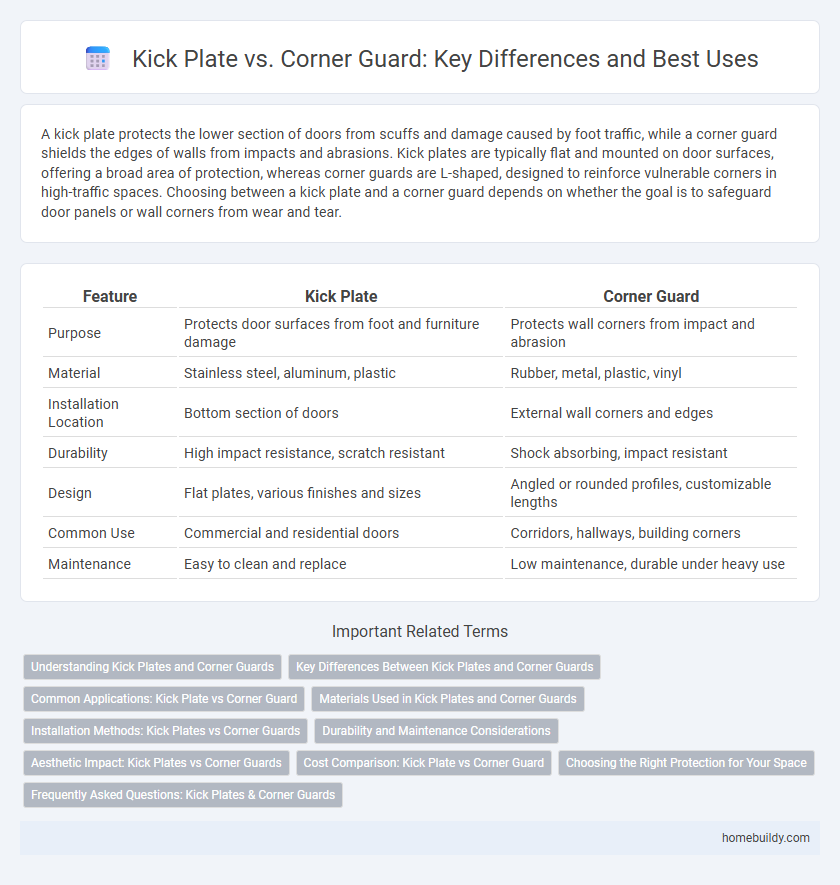A kick plate protects the lower section of doors from scuffs and damage caused by foot traffic, while a corner guard shields the edges of walls from impacts and abrasions. Kick plates are typically flat and mounted on door surfaces, offering a broad area of protection, whereas corner guards are L-shaped, designed to reinforce vulnerable corners in high-traffic spaces. Choosing between a kick plate and a corner guard depends on whether the goal is to safeguard door panels or wall corners from wear and tear.
Table of Comparison
| Feature | Kick Plate | Corner Guard |
|---|---|---|
| Purpose | Protects door surfaces from foot and furniture damage | Protects wall corners from impact and abrasion |
| Material | Stainless steel, aluminum, plastic | Rubber, metal, plastic, vinyl |
| Installation Location | Bottom section of doors | External wall corners and edges |
| Durability | High impact resistance, scratch resistant | Shock absorbing, impact resistant |
| Design | Flat plates, various finishes and sizes | Angled or rounded profiles, customizable lengths |
| Common Use | Commercial and residential doors | Corridors, hallways, building corners |
| Maintenance | Easy to clean and replace | Low maintenance, durable under heavy use |
Understanding Kick Plates and Corner Guards
Kick plates provide durable protection to doors from scuffs, dents, and damage caused by foot traffic, typically installed at the lower portion of doors. Corner guards specifically shield vulnerable wall corners from impact and abrasion, helping to maintain the structural integrity and aesthetic of high-traffic areas. Understanding the distinct functions and optimal placement of kick plates versus corner guards ensures effective damage prevention and prolongs the lifespan of interior surfaces.
Key Differences Between Kick Plates and Corner Guards
Kick plates and corner guards both protect surfaces from damage but serve distinct purposes; kick plates shield lower door areas from foot and equipment impact, while corner guards safeguard vulnerable wall edges from bumps and collisions. Kick plates typically cover a larger flat area on doors and are made of durable metals like stainless steel, offering extensive impact resistance. Corner guards are designed to fit snugly around wall corners, made from materials such as PVC or metal, providing targeted protection to sharp edges prone to chipping or cracking.
Common Applications: Kick Plate vs Corner Guard
Kick plates are commonly installed on doors in high-traffic areas to protect lower surfaces from scuffs, kicks, and damage caused by foot traffic, carts, or equipment. Corner guards are primarily used to shield wall corners in hallways, corridors, and commercial buildings, preventing damage from impacts and abrasions in frequently traveled spaces. Both serve protective functions but are optimized for different surfaces and impact points in commercial and industrial environments.
Materials Used in Kick Plates and Corner Guards
Kick plates are commonly made from durable materials such as stainless steel, aluminum, and bronze, designed to withstand heavy impacts and resist wear. Corner guards typically use materials like rubber, vinyl, and plastic, prioritizing impact absorption and protection for vulnerable edges. The choice of materials directly influences durability, aesthetic appeal, and suitability for different environments in both kick plates and corner guards.
Installation Methods: Kick Plates vs Corner Guards
Kick plates install easily using adhesive backing or screws placed along the bottom edge of doors to protect against foot damage. Corner guards typically require mounting with screws or adhesive on doorframe edges, offering vertical protection along vulnerable corners. Both installation methods prioritize durability and damage prevention, but kick plates focus on horizontal surfaces while corner guards reinforce vertical edges.
Durability and Maintenance Considerations
Kick plates, typically made from heavy-duty materials like stainless steel or aluminum, offer superior durability in high-traffic areas by effectively resisting dents, scratches, and wear over time. Corner guards, often constructed from vinyl or rubber, provide adequate protection for vulnerable edges but may require more frequent replacement due to susceptibility to cracking and deformation under heavy impact. Maintenance of kick plates involves occasional cleaning and polishing to maintain their appearance, whereas corner guards demand regular inspection to prevent deterioration and potential detachment.
Aesthetic Impact: Kick Plates vs Corner Guards
Kick plates enhance door aesthetics by offering a sleek, polished finish that complements various interior styles, while corner guards prioritize protection over appearance, often appearing utilitarian. The seamless integration of kick plates with door designs elevates visual appeal, contrasting with the more noticeable, sometimes bulky look of corner guards. Selecting kick plates contributes to a refined, cohesive environment, whereas corner guards serve as practical, less subtle protective elements.
Cost Comparison: Kick Plate vs Corner Guard
Kick plates typically range from $20 to $80 depending on material and size, offering robust protection for doors against frequent impacts. Corner guards are generally more affordable, priced between $10 and $40, designed to shield wall edges rather than entire door surfaces. Evaluating cost-effectiveness involves considering the installation area and the level of protection required for either doors or corners.
Choosing the Right Protection for Your Space
Kick plates provide durable protection to doors against scuffs and impacts in high-traffic areas, while corner guards specifically shield vulnerable wall edges from damage. Selecting the right protection depends on the area of exposure: install kick plates on lower door surfaces and corner guards on edges prone to collisions or abrasions. Materials such as stainless steel or vinyl contribute to durability and aesthetic integration, ensuring long-lasting defense for your interiors.
Frequently Asked Questions: Kick Plates & Corner Guards
Kick plates and corner guards both protect walls and doors from damage but serve different purposes; kick plates shield the lower portion of doors from foot and cart impact, while corner guards protect vulnerable wall corners from abrasion and knocks. Frequently asked questions often address installation methods, with kick plates typically mounted on doors using screws or adhesive, and corner guards installed on wall angles with similar methods for durability. Material options for both include steel, aluminum, and vinyl, chosen based on environment demands and aesthetic preferences.
Kick plate vs Corner guard Infographic

 homebuildy.com
homebuildy.com